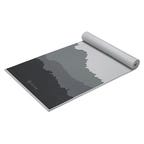
Why You Can Trust CNET
What are you actually going to use?
Getting your home workout zone set up not only saves you money long term, but it can be fun too! Figuring out the best way to use your space and the best type of equipment for your workout style will make it as efficient as possible. There are many options and when you buy expensive equipment, it’s important to know what to look for so you buy things that are worth the price tag.
A well-rounded exercise regimen should include both strength training and cardio, so the equipment you have at home should help to achieve both. Home exercise equipment doesn’t have to take up a ton of space either. We’ve provided a guide for must-have exercise equipment along with some space-saving options as well.
What is the best home exercise equipment?
It’s probably not the right move to single out a “best” piece of home exercise equipment, since what works for you will depend on what type of space you have for a home gym. (Some pieces of exercise equipment are big like furniture, while others are small enough to stash in a drawer.) Also, the kind of equipment that’s right for you will depend on what type of exercise you’ll be doing.
Best home exercise equipment
Show less
A yoga mat is a key piece of equipment to have around. You can use it for low-impact floor exercises, such as Pilates and yoga, or for bootcamps and other higher-impact exercises. Shop with high-quality brand Manduka or an inexpensive one such as Gaiam, which offers non-slip options for all types of workouts. To prolong the life of your yoga mat, make sure to clean it regularly by following CNET’s yoga mat cleaning guide.
Show expert take Show less
Show less
Dumbbells, or free weights, are good to have on hand if you want to start strength training or already have a weight training program in place. Dumbbells come in a variety of weights, so it’s important to have several sets that consist of light, medium and heavy weights. To keep dumbbells stored away neatly, I also recommend getting an A-frame dumbbell rack, which can easily fit most spaces. I like rubber hex style dumbbells, like those from Rogue or CAP: The hexagon shape prevents the dumbbell from rolling away, and the rubber coating creates minimal noise if you drop it.
Since strength varies by person, your own strength will determine which free weights you need. Keep in mind that as you get stronger, you’ll want to increase the weights you use. In some cases, an adjustable dumbbell is a better option because it saves space and offers a variety of weights — usually up to 50 pounds each. A CNET favorite is the Bowflex SelectTech 552 Adjustable Dumbbells, but there are plenty to choose from based on your preference.
Show expert take Show less
Show less
Resistance bands come in a variety of weights, colors and lengths. They’re a good stepping stone toward strength training if you’re a beginner because they can help make certain exercises harder. Mini bands are mostly used for exercises that work the glutes, like squats, hip bridges, hip thrusts, hip abductions, clam shells and more. I’ve also used mini resistance bands to make pushups and core exercises harder. Longer resistance bands can be helpful during squats, deadlifts or assisted pull-ups. They can even mimic cable machine exercises like lat pull-downs, cable rows, tricep extensions or chest presses.
Some tried and true resistance band brands include Rogue and Perform Better. If you’re looking to go high tech, the LIT Axis is a set of smart resistance bands you can use for strength training and Pilates at home or while traveling. You can also keep track of your workout and stats via the LIT app. No matter which option you go with, you can get a solid workout with resistance bands.
Show expert take Show less
Show less
Suspension trainers are a good way to make bodyweight exercises like squats, split squats or pushups easier or harder depending on your goal. They’re usually designed to be anchored behind a door, installed to a ceiling anchor, wrapped around a pull-up bar or even installed outdoors. Suspension trainers resemble some resistance bands because they have handles on the ends, but the difference is they’re made up of nylon straps and can be adjusted. They’re perfect for full-body workouts and take up minimal room, which makes them ideal for a home gym.
The TRX is my favorite suspension trainer. It’s pricey, but it’s made to last. There are more affordable options, including the Lifeline Jungle Gym, and there are others found on Amazon that have similar qualities as the more expensive models.
Show expert take Show less
Show less
An adjustable weight bench is helpful when you’re doing upper body strength exercises that require your body to be flat or on an incline. There are plenty of benches to choose from that incline, decline and can be stored away when not in use. A favorite of mine is the Flybird workout bench, which has an 800-pound weight capacity, adjusts to eight positions, and can then be folded up and stored off to the side.
Some people may prefer a multifunctional bench like the Yes4All Multifunctional Aerobic Deck, that doubles as a weight bench and an aerobic step, and serves as two pieces of equipment. Ultimately the style you choose will depend on the types of exercises you plan on using it for and the room you have to spare.
Show expert take Show less
Show less
Kettlebells are some of the most versatile pieces of equipment you can own because you can use them both for strength training and conditioning. If you’re new to kettlebells, we recommend receiving guidance from a trainer or coach familiar with the tool to teach you the basics. Kettlebells are made up of cast iron and have a handle and round base. They can range anywhere from 5 to 100 pounds and are usually weighed in kilograms. So if you’re looking for a kettlebell that’s approximately 25 pounds, you’d buy a 12-kilogram bell.
There are plenty of brands that manufacture kettlebells, but you want to make sure you’re buying a top quality style so it lasts a long time. Single cast iron with a powder finish, created by well-known manufacturers like Rogue or Kettlebell Kings, is recommended since it’s less likely to feel slippery when in use. An 8- to 10-kilogram (approximately 17 to 22 pounds) and a 10- to 14-kilogram set of kettlebells (about 22 to 30 pounds) is ideal if you’re a beginner who wants both light and heavy weight options.
Show expert take Show less
Show less
Jumping rope might sound like child’s play, but it’s one of the easiest ways to get your heart rate up. Jump ropes are inexpensive and can provide a full body workout in a short period of time. There are different types of jump ropes to choose from: basic, weighted, smart, cordless, beaded and speed. They all serve a different purpose depending on how you plan on using the jump rope. For example if you want to keep track of the number of skips, you’re going to benefit from a smart jump rope. However, if you’re trying to master double-unders, you’re most likely going to prefer a speed rope.
Show expert take Show less
Show less
Medicine balls are another great tool you can use for both strength training and conditioning at home. Usually solid and round, medicine balls are designed with a leather or faux leather exterior. They come in a variety of weights and sizes ranging from 4 to 30 pounds. You can expect to pay more the bigger and heavier the ball is. You’ve probably seen the smaller ones being used for ab exercises, pushups and partner exercises, while the larger ones are typically used for wall balls, ball slams, squats and overhead throws.
Many different manufacturers make medicine balls, but it’s most important to make sure you choose a ball that’s durable and won’t get ruined after repeated use. Some trusty brands for larger medicine balls include Rogue, Dynamax and Titan Fitness, while SPRI and CAP are popular for smaller medicine balls.
Show expert take Show less
Show less
In an ideal world you would be able to fit different types of cardio equipment in your home, but that’s not feasible for everyone. If you have the space for just one large piece of cardio equipment, it’s best to choose the one you know you’re most apt to use. If you’re a runner or enjoy walking you may prefer a treadmill, whereas if you want a steady rate of cardio, you might opt for an elliptical. And if you’re looking for quick bursts of cardio, then you might like a rowing machine. An exercise bike is another option, and you can even splurge and buy the latest Peloton.
There are plenty to choose from. But before you buy, set yourself a budget and make sure you know how much space you have available and the features you want your equipment to have. If you need ideas on where to start, check out our top picks on rowing machines, exercise bikes, ellipticals, and treadmills.
Show expert take Show less
When building your home gym, the question of which pieces suit you best will likely be based on two factors: how much space you have and which equipment you’ll actually use.
Will you actually use it?
If you’re just beginning a new exercise routine, you may want to start with a lower-cost option that’s versatile for a variety of exercises. Something like a yoga mat, which can assist in stretching or core exercises, may be a good first building block.
Next, you’ll want to consider the exercises you like to do and pick equipment that fits the type of activity you do regularly. If you like cardio or are invested in making it a new part of your routine, for example, a cardio machine may be a good choice.
How much space do you have?
Another question to ask yourself is how much space you want to devote to your home gym. Pieces like a jump rope or dumbbells may be easily stashed away, but something the size of a weight bench will take up more room. Here are more tips for building a home gym on a budget.
CNET fitness expert Giselle Castro-Sloboda selected the pieces for this list based on their versatility, exercise type or activity, and how useful they’d be for a home gym.
Do I need all of these pieces for my home gym?
Is it safe to exercise at home?
What else do I need to consider when building a home gym?
The information contained in this article is for educational and informational purposes only and is not intended as health or medical advice. Always consult a physician or other qualified health provider regarding any questions you may have about a medical condition or health objectives.
Fitness Guides























+ There are no comments
Add yours